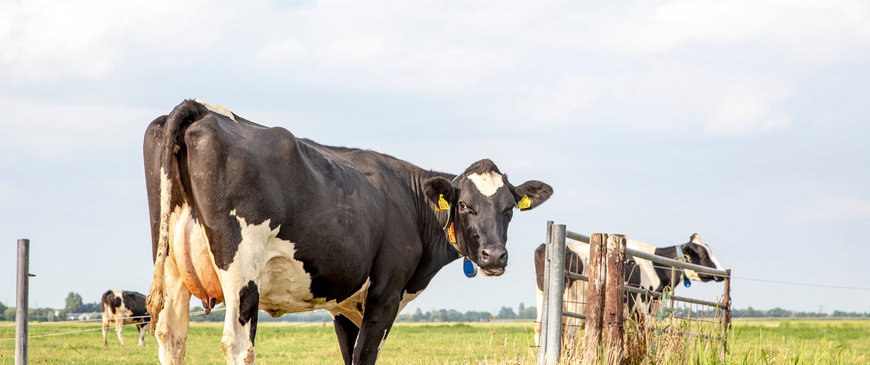
The EU budget needs climate-proofing
Greenhouse gas emissions from Europe’s farms have been flat since 2005. The Common Agricultural Policy, which consumes 37 per cent of the EU’s budget, subsidises a sector that needs to clean up its act.
For all the talk about Europe’s climate leadership, the EU budget is remarkably dirty. The EU has spent far more of its 2014-2020 budget on subsidies to high-emissions sectors of the economy than it has on combating climate change. This is despite the EU spending 20 per cent of its seven-year budget on climate action by the end of 2020. The negotiations over the next budget (the multiannual financial framework, or MFF), which will run between 2021 and 2027, are reaching a critical phase, with final sign-off by the European Council expected in June next year. The European Commission proposes that 25 per cent of the next budget should be spent on climate action, which is remarkably unambitious. More radical change is needed before the EU budget can be considered a contributor to the fight against climate change.
The EU has made important strides in reducing greenhouse gas emissions (Chart 1). Since 1990, emissions have fallen by a little over a fifth across the Union as a whole. The biggest falls were in member-states in Central and Eastern Europe (apart from Poland), which is not surprising, given the rapid decline of inefficient heavy industry after the Berlin Wall fell, and the replacement of dirty energy infrastructure constructed in the communist era. The UK has also made big strides, but from a fairly high base: its greenhouse gas emissions are now only slightly higher than Sweden and Denmark. The laggards are Austria, Malta, Ireland, Spain, Portugal and Cyprus, whose emissions have risen since 1990.
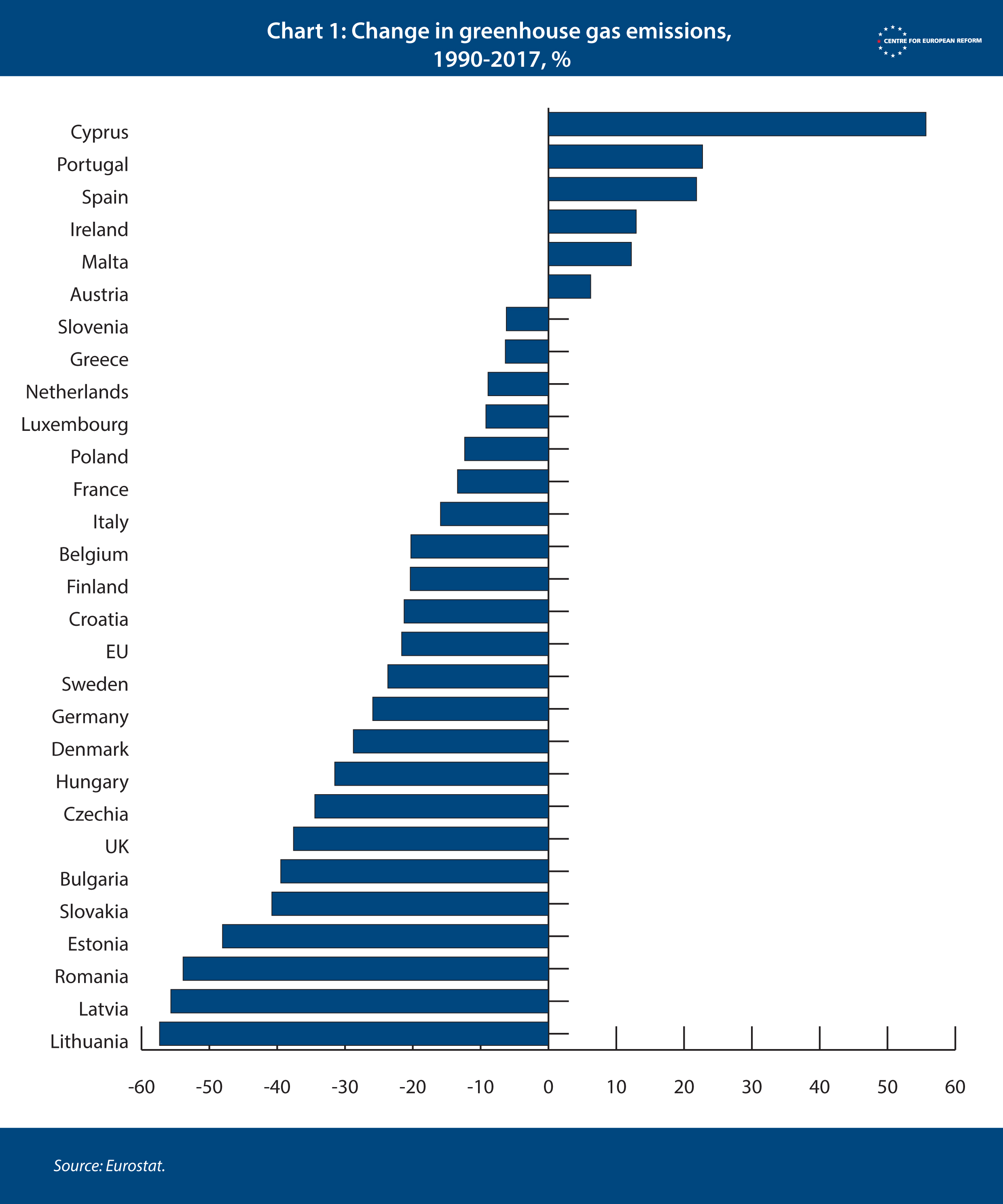
Chart 2 shows how the five most polluting sectors have performed since 1990. Emissions from the energy sector have fallen steeply since 2007, as renewables and gas have replaced coal-fired power plants. Similarly, the industrial sector has performed reasonably well, largely thanks to improved energy efficiency in production processes. But the transport, household and agriculture sectors have performed poorly. Transport emissions have risen by 20 per cent since 1990; while they fell during the Great Recession period, they rose after 2013, when the European economy began its recovery. Emissions from households have only fallen by a fifth, despite the fact that we have the necessary technology to improve the energy efficiency of buildings. Emissions from agriculture fell gradually between 1990 and 2012, but have since crept higher again. Overall, the EU’s emissions from farms were at the same level in 2017 as they were in 2005. The greenhouse gas ‘intensity’ of the farm sector – as measured by emissions as a ratio of agricultural output – has been flat since 2008, at 2,600 tonnes of emissions per € million of gross value added.
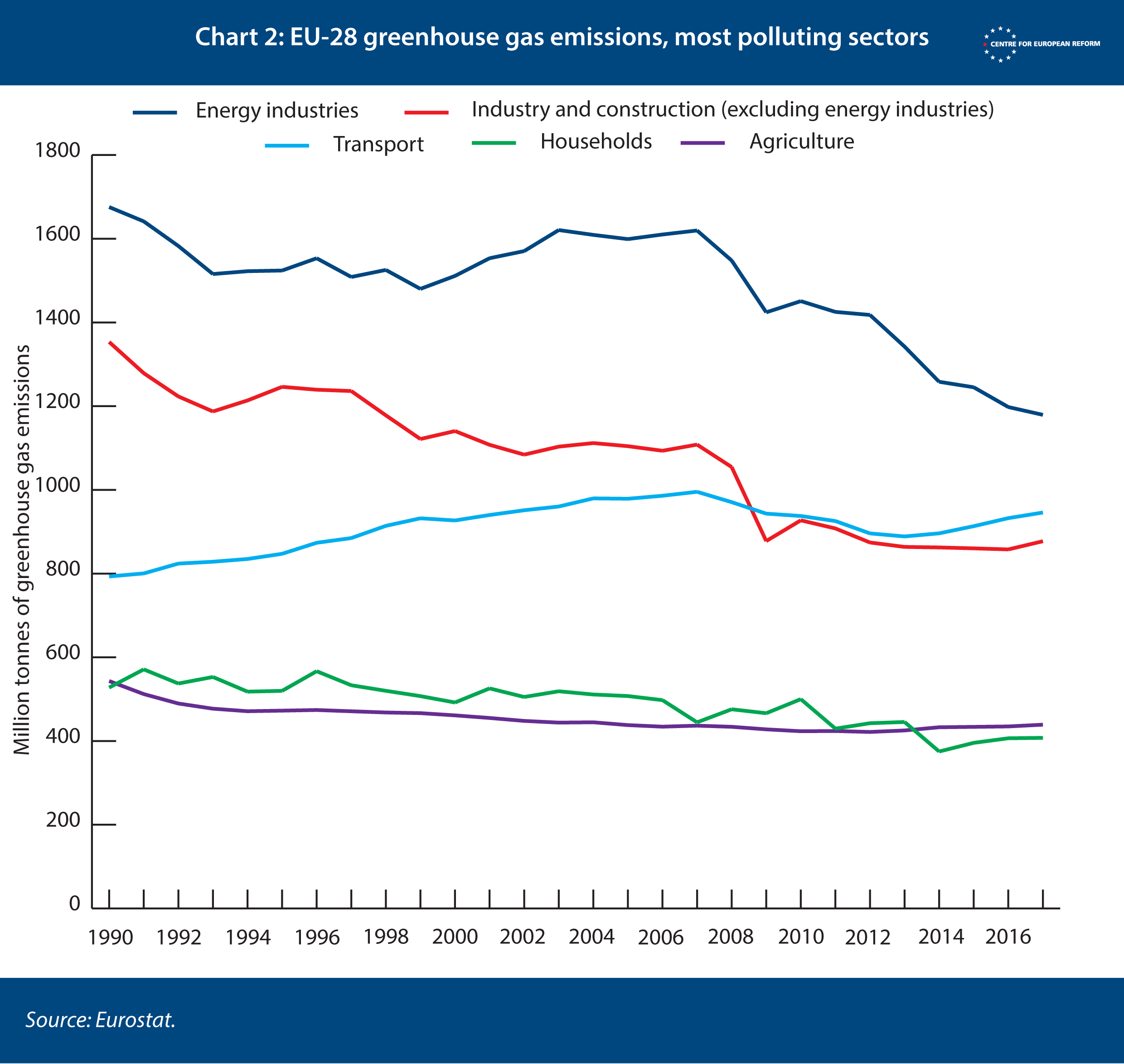
Most climate action in the EU is taken at a national level. Member-states collectively agree to emissions targets that, when combined, result in an overall EU target. The EU’s current target is for a 40 per cent cut from the 1990 level by 2030, which will probably be made tougher in the coming months. The EU’s Emissions Trading Scheme (ETS) has driven decarbonisation in energy and heavy industry. But most policies to achieve EU emissions targets are decided at the national level, through energy market reform, investments in greener modes of transport, and energy efficiency regulations, for example.
However, the EU budget has a sizeable impact on Europe’s greenhouse gas emissions. Between 2014 and 2020, the largest EU budget line is agricultural subsidies (37 per cent of the total budget). The farm sector is a major source of emissions, because of the methane emitted by livestock, and the impact of different farming practices on the ability of the land to sequester carbon dioxide. Another 34 per cent of the MFF is investment spending, including funding for physical infrastructure, improving the productivity of businesses, and training. Most of that investment is concentrated in poorer regions of the Union. Because the EU budget is an important source of funds for physical infrastructure in those regions, the rules determining how EU investment funds are spent have the potential to raise or lower carbon emissions.
How green was the 2014-2020 MFF?
Chart 3 shows estimates of the total expenditure under 2014-2020 MFF on farming, housing, transport, industry, energy and research (in billions of euros). These estimates were obtained using the European Commission’s data on climate expenditure in four spending programmes (the European Regional Development Fund, the Cohesion Fund, the European Social Fund, and the Youth Employment Initiative), as well as data on research and agriculture spending. The chart divides the spending into funding for climate action and non-climate expenditure.
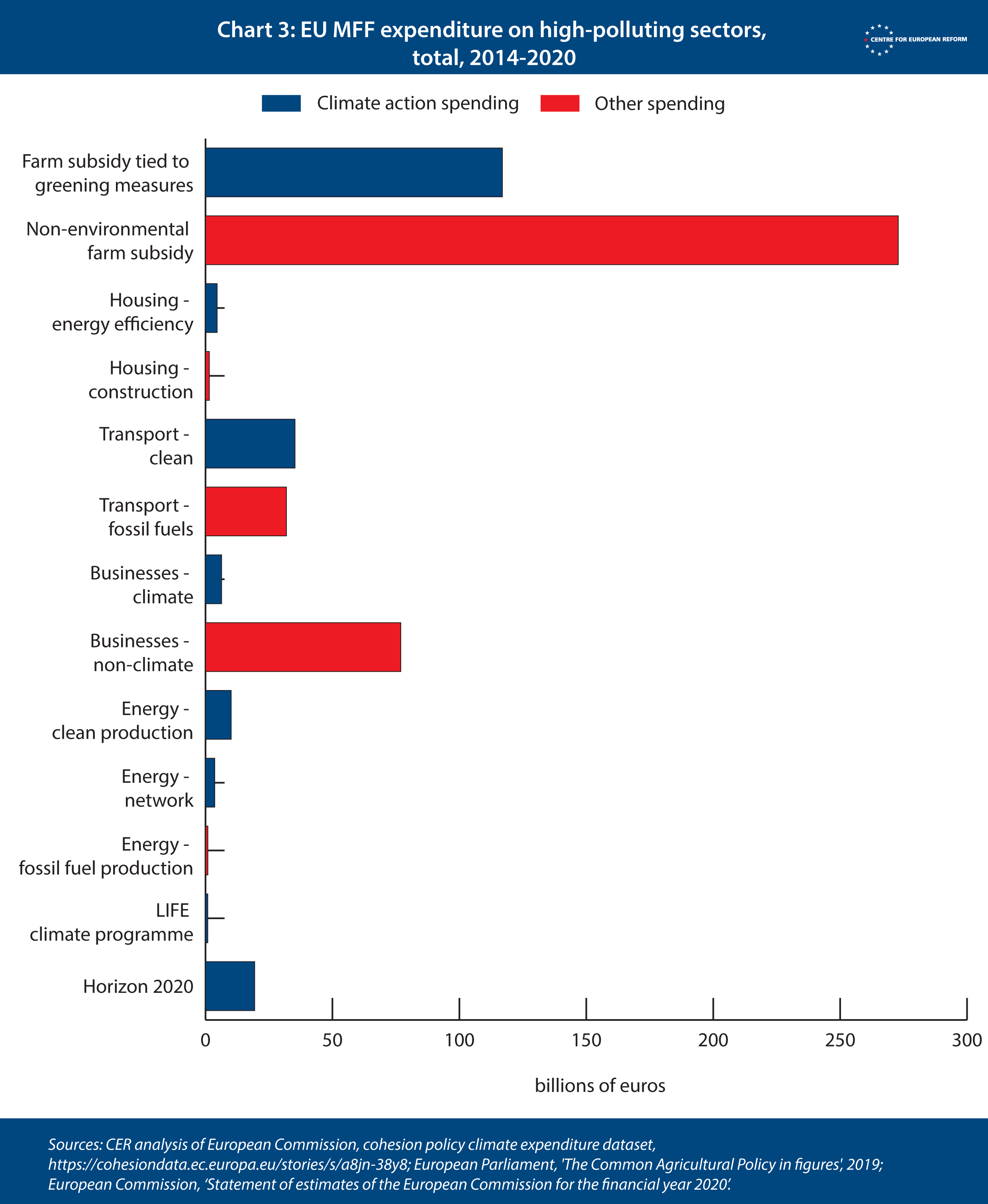
Let’s appraise EU spending on each high-emissions sector in turn.
- Energy. The sector with the highest emissions, energy production and networks, receives relatively little EU expenditure, because most energy production in the EU is conducted by large, well-capitalised private businesses, and the member-states use a combination of subsidies and regulation to shape their own energy mixes. Only €0.9 billion of the EU’s spending will be on fossil fuels over the current MFF, largely on natural gas pipelines under the EU’s ‘Connecting Europe’ programme. Meanwhile, the EU is spending €3.6 billion on improving the efficiency of transmission and storage of energy, which reduces energy use, and €10.9 billion on clean energy generation.
CLIMATE RATING: GOOD
- Research. The EU will spend a quarter of its Horizon 2020 research and innovation funds on climate over the course of the 2014-2020 round, as well as a much smaller dedicated research and technology programme on the environment, called LIFE.
CLIMATE RATING: GOOD
- Transport. The EU has spent similar amounts on green and fossil-fuel based transport (€35 and €32 billion respectively) over the last budget. Most green expenditure has been on rail and urban mass transit systems. The overwhelming majority of funds on fossil-fuel based transport - €30 billion – will be spent on roads in poorer regions of the EU. The small remainder were on upgrading airports and seaports. While it is not ideal to be spending so much on a sector where greenhouse gas emissions have been rising, road-based transport can be decarbonised by the use of electric vehicles. Therefore roads constructed with EU money will not lock-in higher emissions in the long-term, so long as Europe’s car fleet shifts rapidly to electric power. The electrification of road infrastructure should be a priority in the next MFF.
CLIMATE RATING: FAIR
- Businesses. The EU is spending €6 billion on improving the climate record of business (excluding the energy sector), and €76 billion on other forms of subsidy. Climate funding is largely for energy efficiency projects. The other forms of subsidy include R&D, training, technology and knowledge transfer between businesses. The European Commission data used to estimate EU expenditure does not differentiate between heavy industry and manufacturing (which tend to be large emitters of greenhouse gases) and the services sector, so it is hard to tell how much funding is being channelled towards higher polluting business activities. But, since the industrial and construction sectors are such large sources of Europe’s greenhouse gas emissions, it is surprising that only €6 billion is being spent on improving energy efficiency and curbing emissions from industrial processes.
CLIMATE RATING: FAIRLY POOR
- Households. Most emissions from the household sector arise from gas and electricity consumption. The International Energy Agency estimates that buildings are responsible for 40 per cent of greenhouse gas emissions globally. The technology to improve energy efficiency in buildings is mature: it is possible to retrofit existing buildings to improve heat loss, and new buildings can have near zero emissions. Housing energy efficiency is thus technologically straightforward, but very expensive, given how long it takes to upgrade Europe’s stock of buildings. However, only €4.6 billion (0.4 per cent) of the EU’s expenditure is being spent on improving household energy efficiency between 2014 and 2020.
CLIMATE RATING: POOR
- Agriculture. Farming makes up around 1.5 per cent of the EU’s economy, but is responsible for 9 per cent of its greenhouse gas emissions. The EU, through the Common Agricultural Policy (CAP), spends more on subsidies to farms than on any other sector. In the current MFF, there are measures to encourage farmers to reduce emissions. But, as noted above, emissions in 2017 were at the same level as they were in 2005, and the emissions intensity of the sector has been flat since 2008. This means the EU’s budget is providing very large subsidies to greenhouse gas emissions in the agricultural sector. Most CAP expenditure falls under two ‘pillars’. The first is subsidy to farmers based upon the amount of land that they farm. In order to receive that subsidy, they must comply with a series of environmental standards on the use of water, protecting biodiversity, and farm practices that protect ‘carbon sinks’, by preventing soil erosion for example. Under the second pillar, funding is provided to rural development projects rather than to farms directly, but climate action makes up only a small part of that funding. The weak climate conditionality attached to CAP has resulted in a poor emissions record for agriculture as a whole.
CLIMATE RATING: VERY POOR
Overall, whereas the EU will spend around €220 billion on climate friendly initiatives by 2020, €305 billion will be spent on subsidies for heavy emitters, largely in the form of farm subsidies.
Climate-friendly reforms to the 2021-2027 EU budget
In its proposal for the next MFF, the European Commission recommended that 25 per cent goes to climate action, up from 20 per cent in the previous budget. It also proposes that CAP and fisheries spending falls from 37 per cent to 29 per cent, which would, if the member-states agree, reduce the large greenhouse gas subsidy inherent in the Union’s farm payment programme. For its part, the European Parliament is pressing for a 30 per cent target for climate expenditure, and green lobby groups for 40 per cent.
While higher targets for climate action would be welcome, national leaders always bargain over first, the size of the overall budget, and second, maximising the payments that flow to their country. France usually tries to limit cuts to CAP, as it is the policy’s largest beneficiary, while Greece, Poland, Hungary, Romania and other poorer member-states press to maintain cohesion policy funding. So the EU needs to ensure its money is spent effectively on reducing greenhouse gas emissions, given those political constraints. Continuing with my sectoral approach, I outline some of the Commission’s proposals and suggest improvements below.
- Energy. The Commission has proposed that fossil fuel energy generation will not be funded under the next MFF. But it has not excluded the transmission of natural gas through the construction of pipelines. Although there was a small amount of funding for natural gas in the last MFF, there is little reason for the EU to be subsidising the construction of fossil fuel infrastructure, especially when borrowing costs for governments and private energy businesses are so low. A tenth of the Connecting Europe facility will include funding for cross-border renewables projects. This could be higher: more interconnectors between member-states would help to counteract problems with intermittency in solar and wind power.
- Research and innovation. The Commission recommends that the next Horizon research programme, ‘Horizon Europe’, is 30 per cent bigger, and that 35 per cent of funding goes on climate related projects. €10 billion will also be spent on the Innovation Fund that will help to commercialise risky climate technologies that struggle to find cheap funding in financial markets. That should be higher, since existing technology will not be enough to decarbonise the economy, and new technology is needed very rapidly. The innovation fund will be financed with some of the revenues from allowances auctions under the Emissions Trading Scheme; and the Commission would like to earmark more revenues from the sale of these allowances to climate action. One way to further raise funding for new climate technology could be to earmark revenues from a carbon border tax scheme, if such a scheme can be made to work.
- Transport, businesses and households. The EU mostly funds transport, businesses and households though its cohesion policy. The Commission proposes stronger conditionality under this policy, with member-states explaining how they will meet a more precise set of ‘policy objectives’ with the Commission before they receive money. Member-states will have to agree a “comprehensive transport plan” with the Commission, as well as plans to renovate and construct energy efficient buildings, in order to receive funding in those sectors. The Commission’s proposals could be tightened further by requiring member-states to demonstrate how cohesion policy funding will be used to meet binding sectoral climate targets for reducing emissions from housing, waste and transport.
- Agriculture. The Commission’s proposal to make a large cut to CAP has been strongly criticised by the French, Finnish, Slovak and Portuguese governments. While such cuts make a good deal of sense from a climate perspective, because they amount to a redistribution from a high-emissions sector to climate action, member-states with big agricultural sectors have successfully limited CAP cuts in the past. However, income support for farmers could, as the Commission proposes, be better targeted, with large farms receiving less support than smaller farms on more marginal land, with subsidy being used to return some of their land to nature. This would allow overall levels of subsidy to be cut without impoverishing agricultural communities. Tougher environmental conditions for receiving subsidies should also be a priority: the Commission proposes, sensibly, that it agrees environmental criteria with the member-states that farmers must meet to receive funding, which are based upon the particular environmental needs of each country. Under the Commission’s proposals, there will be continuing evaluation of these plans through the course of the MFF.
The new president of the European Commission, Ursula von der Leyen, wants action against climate change to be the “hallmark” of her period in office. But with agricultural subsidies making up such a large proportion of expenditure and the failure to make any progress in reducing greenhouse gas emissions from farms over the last decade, the last MFF spent more on subsidising high-emitting sectors than it did on climate action. The Commission’s proposal for the next MFF would be a big step forward if the member-states do not bargain its environmental benefits away, as the proposal would amount to a sizeable shift from emissions subsidy to investment in curbing climate change. If Europe is to have any hope of reaching net zero emissions by mid-century, the EU’s budget will have to play its part.
John Springford is deputy director of the Centre for European Reform.

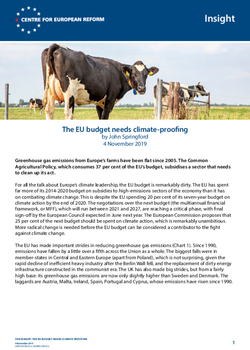
Add new comment